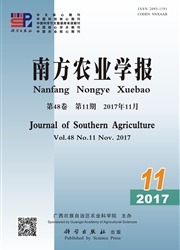

 中文摘要:
中文摘要:
【目的】分析十大功劳属6个种的遗传多样性及亲缘关系,为其资源保护和开发利用提供参考依据。【方法】采集十大功劳属6个种植物样品,提取基因组DNA,采用优化的RAPD反应体系和条件进行多态性检测,分析多态性条带规律,并用NTSYS-pc Version 2.11a进行数据分析,计算遗传相似系数,用非加权配对算术平均法(UPGMA)进行聚类分析,生成聚类图。【结果】十大功劳属6个种的21条重复性好、稳定性高的有效引物共扩增出264条条带,其中多态性条带234条,多态性比例为88.64%,多态性信息含量(PIC)为0.373~0.414;6个种的遗传相似系数为0.45~0.78。UPGMA聚类分析结果表明,在遗传相似系数0.53处,6个种可分为3个组,其中阔叶十大功劳M.bealei和小果十大功劳M.bodinieri Gagnep.为一组,靖西全缘叶十大功劳M.jingxiensis为一组,其他3个种为一组;在遗传相似系数0.59处,细叶十大功劳M.fortunei单独为一组,长柱十大功劳M.duclouxiana Gagnep.和靖西十大功劳M.subimbricata W.Y.Chun et F.Chun为一组。【结论】十大功劳属6个种植物具有较丰富的遗传多样性,部分种之间有较近的亲缘关系。
 英文摘要:
英文摘要:
[Objective]The present experiment was conducted to analyze genetic diversity and genetic relationship for 6 species of Mahonia, in order to provide reference basis for development, utilization and protection of Mahonia resource. [Method]The leaf samples were collected from 6 species of Mahonia , and their genomic DNA were extracted. The opti, mized RAPD reaction system and conditions were used to detect polymorphism of Mahonia. The polymorphie bands were recorded and their regularities of distribution were analysed, then the genetic similarity coefficient (GSC) was calculated by NTSYS-pe Version 2.11a software. Unweighted pair-group method with arithmetic means (UPGMA) was used to make cluster analysis, and generate clustering figure. [Result]A total of 264 bands were amplified with 21 primers of high reproducibility and stability, 234 of which were polymorphic, accounting for 88.64% of amplified products. The polymorphic information eontent(PIC ) ranged from 0.373 to 0.414. The genetic similarity eoefficient(GSC) between every 2 species ranged from 0.45 to 0.78. UPGMA analysis showed that 6 species of Mahonia could be divided into three groups, when GSC was 0.53, M. bealei and M. bodinieri Gagnep. were clustered into Group Ⅰ, M. jingxiensis were clustered into Group Ⅱ, and the other three species were clustered into Group Ⅲ. When GSC was 0.59, Group Ⅲ could be divided into two subgroups, M. fortunei was clustered into Subgroup Ⅰ, and M. duelouxiana Gagnep. and M. subimbncata W.Y. Chun et F. Chun were clustered into Subgroup Ⅱ. [Conclusion]Six species of Mahonia have abundant genetic diversity, and there exist close genetic relationships among some species.
 同期刊论文项目
同期刊论文项目
 同项目期刊论文
同项目期刊论文
 期刊信息
期刊信息
